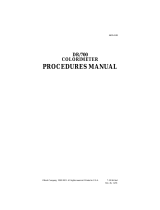Page is loading ...

POTASSIUM MODULE
FOR SOIL MACRONUTRIENTS KIT • CODE 5928-01
TURBIDITY TUBE, 100 - 400 lbl/acre
CODE 5932-01
QUANTITY CONTENTS CODE
120 mL Universal Extracting Solution 5173PT-J
120 mL Universal Extracting Solution 5173PS-J
50 *Potassium B Tablets *5161A-H
120 mL *Potassium Reagent C *5162-J
1 Test Tube, Potash “B” 0246
4 Test Tubes, 1-8 mL, plastic, w/cap 0755
1 Funnel, plastic 0459
1 Filter Paper, 50 pk 0465-H
1 Pipet, plastic 0364
1 Spoon, 0.5 g 0698
1 Potash Reading Plate 1107
1 Test Tube, fi ltrate, plastic 0749
1 Dispenser Cap 0692
*WARNING: Reagents marked with an * are considered to be potential health hazards.
To view or print a Safety Data Sheet (SDS) for these reagents go to www.lamotte.
com. Search for the four digit reagent code number listed on the reagent label, in the
contents list or in the test procedures. Omit any letter that follows or precedes the four
digit code number. For example, if the code is 4450WT-H, search 4450. To obtain a
printed copy, contact LaMotte by email, phone or fax.
Emergency information for all LaMotte reagents is available from Chem-Tel:
(US, 1-800-255-3924) (International, call collect, 813-248-0585).
To order individual reagents or test kit components, use the specifi ed code number.
For a discussion of the importance of potassium, see A Study of Soil Science (Code
1530) by Dr. Henry D. Foth.
NOTE:
It is important the temperature of the test sample and the *Potassium Reagent C
be kept between of 20-27°C (68-80°F) during the test, in order to ensure complete
precipitation of the potassium. On warm days the vial containing the test solution to
which the *Potassium Reagent B Tablet has been added and the *Potassium Reagent C
should be cooled by placing them in cool water before mixing.
Place dispenser cap (0692) on *Potassium Reagent C (5162). Save this cap for refi ll
reagents.
Warning! This set contains chemicals
that may be harmful if misused. Read
cautions on individual containers
carefully. Not to be used by children
except under adult supervision.

PROCEDURE
1. Fill a test tube (0755) to line 7 with Universal Extracting Solution (5173).
2. Use the 0.5 g spoon (0698) to add four level measures of soil. Cap tube and shake
for
one minute.
NOTE: When adding samples with high concentrations of carbonates to Universal
Extracting Solution (5173), swirl tube to mix for 30 seconds before capping to
allow gases to escape.
3. Fold a piece of fi lter paper (0465) in half. Fold in half again. Gently push corners
together to form a cone. Place cone in funnel (0459).
4. Place funnel in clean fi ltrate tube (0749) and fi lter suspension through the fi lter
paper.
The clear solution is the extract used in the test.
5. Fill a clean test tube (0755) to line 3 with soil extract.
6. Add one *Potassium B Tablet (5161A). Cap and shake until tablet disintegrates.
7. Add *Potassium Reagent C (5162) to line 7. Allow it to run slowly down the side
of the tube. Cap and mix gently. A precipitate will form if potassium is present.
8. Place a Potash Tube “B” (0246) on the Potash Reading Plate (1107) directly over
the black line.
NOTE: Face a window or some other source of daylight.
9. Use a pipet (0364) to add the treated test sample slowly to Tube “B” allowing it to
run down the sides of the tube while observing the black line through the solution.
Continue until the line just disappears.
10. The height of the column of test sample is measured against the potassium scale
on the tube. Record as pounds per acre potassium.
NOTE: For extremely high readings, dilute the fi ltered extract and retest. Add
the
soil sample fi ltrate to line 3 of a clean test tube (0755). Dilute to line 6 with
*Universal
Extracting Solution (5173). Test following the procedure beginning
with Step 5. Multiply fi nal reading by 2.
PRECAUTION: Large amounts of ammonium salts will produce a precipitate
similar
to that obtained with potassium. If fertilizer containing ammonium salts has recently
been added to the soil, or if the soil pH is low (pH 4.0-
5.0), a test should be made for
ammonium compounds. Equivalent quantities
of ammonium salts will produce about
one-fourth as much precipitate as obtained from potassium salts.
LaMOTTE COMPANY
Helping People Solve Analytical Challenges
PO Box 329 • Chestertown • Maryland • 21620 • USA
800-344-3100 • 410-778-3100 (Outside U.S.A.) • Fax 410-778-6394
Visit us on the web at www.lamotte.com
65932-01 12/19
/



